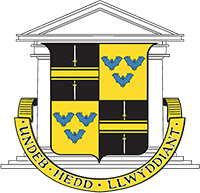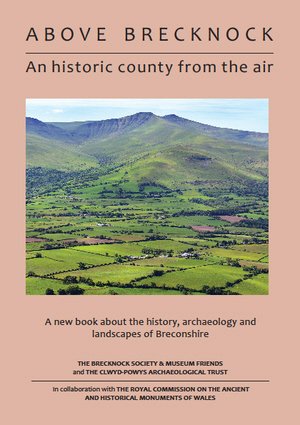Books
Above Brecknock: An Historic County from the Air by Chris Musson and Toby Driver
The Brecknock Society & Museum Friends in collaboration with The Royal Commission on the Ancient and Historical Monuments of Wales and the Clwyd-Powys Archaeological Trust.
Paperback: 128 pages. £15.00.
ISBN-10: 1869900022 ISBN-13: 978-1869900021
-
It was a great pleasure to receive and read this high quality publication, which is the third in Chris Musson’s excellent trilogy of aerial views following Montgomeryshire Past and Present from the Air in 2011 and Radnorshire from Above in 2013. A far cry from many rather mass produced and eclectic collections of regional aerial views which are readily available on the ‘mass market’, this is an outstandingly high quality, brilliantly illustrated and thoughtfully written book.
Threaded throughout by both author’s deep knowledge of the area and skilled appreciation of the important and unique aspect afforded by the aerial viewpoint, the volume provides an insightful, detailed and visually charming overview of the archaeology and history of Brecknock via a series of carefully chosen, excellently composed and often dramatic aerial images supported by an engaging, intellectual and accessible text. It successfully entwines the physical aspects of the area with the huge social, economic, cultural and heritage significance of this magnificent landscape.
Pages 12 and 13 provide a succinct accurate and comprehensive overview of aerial survey techniques and equipment, accurately describing aerial archaeologists as ‘multi-period archaeologists chauffeured by even more experienced pilots in a variety of search patterns around the chosen survey area’. Importantly the authors point out that ‘The archaeologists choose what to photograph, so anything they do not see - or recognise as being of potential archaeological value [during oblique specialist aerial surveys] does not get photographed …. But every photograph is ‘informed by archaeological knowledge and archaeological purpose’.
Varied views, and particularly photo 11, show the reader what it is like to undertake an aerial survey – from required equipment to what it actually looks like to compose an aerial photo from the window of a small light aircraft. The role of GPS navigation and route planning is briefly discussed, with the caveat that the best planned routes may be (excitingly!) diverted by changing weather conditions – frequent in mountainous regions – and the initial observations of the landscape below. The anticipation of discovery, meticulous planning and experience involved in successful aerial survey is neatly described in two well illustrated pages, which continue into informative discussions of the Way of Seeing from the air and Archaeology from the Air.
Regional overview chapters, from Hay-on-Wye to Crickhowell, Brecon and the Valley of the Usk, Builth, Mymydd Epynt and Llanwrtyd and the Brecon Beacons to the coalfield fringe pack in a lot of information and illustrative images useful to the professional archaeologist and lay-person alike. The many photographs, carefully chosen from the authors own images and from other archives, are all sharply and beautifully reproduced and printed, with a wide range of distant well composed and focussed landscape images with an impressive depth of field, such as photo 113, a panorama of Ystradgynlais, photo 93 of Mynydd Du and the stunning photo 87 of the Brecon Beacons under snow. These are complemented by crisp, detailed and informative close-in photos of individual features within a wider landscape, such as the stone sheepfold illustrated by photo 116 west of Craig-y-Nos. Townscapes and dramatic industrial landscapes also take their place alongside well-lit photos of earthworks, buildings and buried sites showing as marks in growing crops.
Other photos illustrate the massive variety of dramatic landscape (photo 1, the Black Mountains) the effect of snow and different weather conditions (photo 15, Brecon Gaer) on archaeological discovery and the subtle perception of differing landscape zones and types via angle of photography and textural rendition of vegetation. Photographs 81 and 82 show a former peat cutters sledway and ruined longhouse within a valley near Abergwesyn. Not only are the images of these sites very informative and sensitively composed, but they are indeed difficult to capture during aerial survey in a light aircraft in a mountainous region. They are a tribute to the skills, communication and teamwork of both the pilot and the aerial archaeologist.
All images in this book really do show the range of skills and abilities needed to achieve successful aerial survey alongside the archaeological appreciation and knowledge necessary to deliver such fine results in communicating a landscape to readers on many levels.
The final section ‘Into the Future’ begins with one of the most stunningly visualised LiDAR (Airborne Laser Scan) images I have ever seen, and continues to provide a very succinct yet informative and engaging history of aerial survey in Brecknock from the days of biplanes to the present innovative and fast moving developments in the use of digital images and LiDAR imagery as applied to the study of an Iron Age landscape at Coed Gibraltar promontory fort.
The authors certainly have captured the county’s character and analysed and presented it in depth with the right balance of words and deeply informative images.
Finally they ask the much-hackneyed question ‘does the future belong to the drones?’ which is almost a rhetorical finishing note, to which the answer is of course a resounding ‘No’. This volume amply illustrates that the future firmly belongs to skilled human aerial surveyors and landscape interpreters operating over a wide area, on many occasions of survey, responsive to changing light, new discovery and their own experienced knowledge to produce information on any level other than a straight single image of a known site.
This book is a tight, informative and evocative focus of the immense archaeological knowledge and purpose developed by the authors over their long experience as aerial archaeologists and specialists in the cultural heritage and archaeology of this wild and beautiful region of Wales. It is as academically and professionally informative as it is accessible to a lay reader, due to its clear and stylish visually appealing content and exceptionally well written and succinct text.
The authors have amply achieved their stated aim to ‘hopefully enrich our readers’ sense of identity and place as we take them on our imaginary flights round the varied landscapes, townscapes and archaeological sites of the historic county of Brecknock’ in producing a book which is not only a pleasure to read but is beautiful to look at and contains many memorable and stunning photos which amply illustrate the informative unique and complex art of aerial photography and its detailed application to multi-period landscape survey.
CHRIS COX
Director, Air Photo Services Ltd.
Henry Vaughan and the Usk Valley edited by Elizabeth Siberry and Robert Wilcher.
2016. Logaston Press. Paperback: 110 pages. £10.00.
ISBN-10: 1910839027 ISBN-13: 978-1910839027.
-
It is remarkable that Henry Vaughan, who died at the age of 74 in 1695, completed his most admired poetical works about halfway through his life. He continued thereafter in the practice of medicine in the neighbourhood of his birthplace in Llansantffraed in the Usk Valley. His metaphysical poetry faded from critical view until the arrival of Romanticism. Later in the nineteenth century several editions of Vaughan’s works were published.
The first definitive biography was written in 1947 by Francis Ernest Hutchison who drew extensively upon the material lovingly collected by American Louise Guiney and her correspondent, local enthusiast Gwenllian Morgan, over the previous quarter of a century (see Jonathan Nauman’s article in this volume). A wealth of analysis and research into his works is now available, much of which is directed at the specialist scholar and does not encourage the passing reader to stop and seek a solid appreciation of Vaughan’s poetry and its background: the troubles of his twenties and thirties; his religious devotion; his immersion in the local landscape; and his reverence for nature. Henry Vaughan and the Usk Valley is a superbly organised collection of eight thematic essays that shine a modern light on facets of his character but especially illuminates his seventeenth-century visionary and devotional thoughts by very readable analyses of selected poems.
Following a biographical introduction by the editors, Jeremy Hooker explores Vaughan’s relation with the landscape in which he passed his life, especially the River Usk and adjacent mountains. The interplay of light and water fascinated Henry (and his twin brother poet, Thomas). Examples of verse that perfectly illustrate this are presented and for the newcomer to seventeenth-century poetry, end notes explain the poets’ allusions. The use of such end notes for nearly fifty poems is a most valuable feature throughout the book.
Robert Wilcher uses his mastery of political and religious conflicts and of poetry of the time to select works of Henry Vaughan from which the tumult of the Civil War cries out. He follows this with an exposition on the outrage evident in the poems caused by the religious diktats of those who had usurped the monarchy during the interregnum.
Helen Wilcox presents Vaughan’s pastoral purpose as one of three strategies poetically deployed in reconstructing the Church’s ‘ancient way’. The presence of God ‘everywhere’ is the second. The re-establishment of the church in one’s own spiritual strength complete her suggested trinity of reinvigoration of what, in modern terms, would be a personal virtual church.
American scholar Jonathan Nauman perceives an inclination in the sacred works, including elements of hermetic thought, to let the natural world speak for itself as God’s creation and help humanity forgo sin. He also presents the view that Henry Vaughan was a poet who transfigured the Usk Valley into a mystical literary prototype, a Book of Nature. There is little overlap of the poems selected by Hooker in discussing Vaughan and landscape, and Nauman in discussing Vaughan and nature, the exceptions being Regeneration and The Waterfall.
Simone Thomas, herself a GP, carefully investigates his study of medicine evidenced by several of his own medical texts in Latin that he annotated. She concludes that he was a traditional country doctor whose practice was almost certainly based on herbal medicine, methods he may have known from early age. He was not however, ignorant of iatrochemistry, the use of chemicals in treatments.
The rediscovery of Henry Vaughan’s life and work in the nineteenth century and his subsequent influence on later poets, authors, composers, and illustrators up to the present day is comprehensively explained by Elizabeth Siberry.
Altogether the essays provide an eightfold path to the understanding and enjoyment of the poetry of Breconshire’s most famous son.
Henry Vaughan and the Usk Valley was jointly commissioned by the Brecknock Society and the Vaughan Association. There are many colour photographs; these and other illustrations greatly enhance the printed word. Each essay has a list for further reading. An excellent index is provided together with a guide list of the poems included. This book will be a landmark in the literature of Henry Vaughan and should bring him to a wider public.
SEAMUS HAMILL-KEAYS
The Vaughan Association


